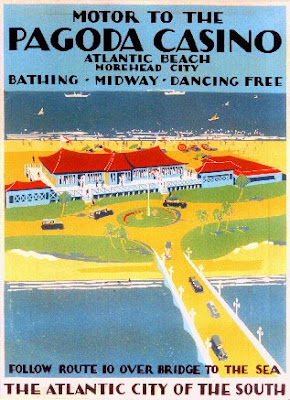 |
| Atlantic Beach, Beaufort.Morehead City, NC circa 1933 |
Just past the Beaufort Inlet, are the cresting ocean waves of the Atlantic Ocean. In the early days, through the Civil War, until the late 1880s, Bogue Banks was totally undeveloped and reachable only by boat. Jennie Coues, wife of Dr. Coues, stationed at Fort Macon after the Civil War, played with her daughter on the beach, and often galloped freely on horseback.
“Bogue Banks had its start with a fort [Fort Macon] on the eastern end and small fishing villages along the beach. From this small beginning came the beach resort of Atlantic Beach
"J.J. Royal and Winfield Chadwick built a small pavilion, one-story bathhouse and refreshment stand on Bogue Banks’ ocean beach in 1887. Boats for hire took people to the sound side of the beach, where they walked across the sand and dunes to reach the ocean for surf bathing. When the partners split their interests, Royal moved west toMoney Island Atlantic View Beach
"J.J. Royal and Winfield Chadwick built a small pavilion, one-story bathhouse and refreshment stand on Bogue Banks’ ocean beach in 1887. Boats for hire took people to the sound side of the beach, where they walked across the sand and dunes to reach the ocean for surf bathing. When the partners split their interests, Royal moved west to
"Tourists used the beach for years before Atlantic Beach Money Beach Money Beach Atlantic Beach Money Beach
"The building of the toll bridge by the Atlantic Beach Company in 1928 helped to create the resort of Atlantic Beach
"To promote the beach, they also built a dining hall, bathhouses and the Pagoda. These were constructed in an Oriental style and had green roofs with bright red exposed corners. The Pagoda was a large building where dances were held. Featured were such well-known orchestras as Paul Whiteman and Tommy Dorsey.
 |
| Pagoda Ball Room, Atlantic Beach, Beaufort. Morehead City, NC |
"Alfred Braswell Cooper is credited with having a vision for developing what many viewed as an island desert into the resort Atlantic Beach Idle Hour Amusement Center Fort Macon
 The above text and postcards were taken from Carteret County - Postcard History Series, by local residents Linda Sadler and her son Kevin Jenkins. It is a collection of old postcards with descriptive histories under each card - of Beaufort,
The above text and postcards were taken from Carteret County - Postcard History Series, by local residents Linda Sadler and her son Kevin Jenkins. It is a collection of old postcards with descriptive histories under each card - of Beaufort, On the Front Cover: The Morehead City Boating Club was founded in 1934, sponsoring such races as the Shanghai Trophy, the Gib Arthur Memorial Trophy and the D.G. Bell Memorial Trophy. The flag, called Old Mullet, designed by D.G. Bell, distinguished the boats. The club also sponsored the Junior Boat Club. These clubs were active until World War II put a stop to pleasure boating.
________________________________________________________________
(not included in the book)






